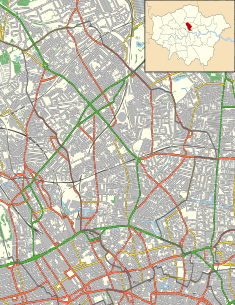Finsbury Town Hall
| Finsbury Town Hall | |
|---|---|
 The town hall in 2014 | |
| Location | Rosebery Avenue, Finsbury |
| Coordinates | 51°31′36.97″N 0°6′29.13″W / 51.5269361°N 0.1080917°W |
| Built | 1895 |
| Architect | William Charles Evans-Vaughan |
| Architectural style(s) | Flemish Renaissance Revival style |
Listed Building – Grade II* | |
| Designated | 29 December 1950 |
| Reference no. | 1293112 |
Finsbury Town Hall is a municipal building in Finsbury, London. The structure is a Grade II* listed building.[1]
History
[edit]The building was commissioned by the Clerkenwell Vestry to replace an early 19th century vestry hall at the corner of Garnault Place and Rosoman Street which had been described as "the smallest and worst vestry hall in London".[2] The site chosen for the new building was just to the north of the old vestry hall.[3]
The foundation stone for the new building was laid on 14 July 1894.[4] It was designed by William Charles Evans-Vaughan in the Flemish Renaissance Revival style and built by Charles Dearing of Islington; it was officially opened by the Prime Minister, Lord Rosebery, as Clerkenwell Town Hall on 14 June 1895.[4] The design involved an asymmetrical main frontage with nine bays facing onto Rosebery Avenue; the central section featured a projecting cast iron porch flanked by composite order columns on the ground floor; there was an arched opening containing a Venetian window on the first floor and a four small windows on the second floor with a projecting clock above.[1] The clock was by Thwaites & Reed.[4] Internally, the principal rooms were the great hall, which was elaborately decorated in a Belle Époque style, and the council chamber which had a vaulted plaster ceiling supported by Ionic order columns.[1] The great hall was illuminated by sculptures of female figures, known as the "Clerkenwell Angels", which were designed by Jackson & Co. and which supported brass light fittings, made by Vaughan & Brown.[5]
The original vestry hall was demolished in the late 1890s, allowing the new building to be extended to cover the whole area enclosed between Rosebery Avenue, Garnault Place and Rosoman Street.[1] The new building became the headquarters of the enlarged Metropolitan Borough of Finsbury in 1900.[4] During the Second World War an air raid shelter and control centre was built under Garnault Place with access from the town hall; this facility was then maintained as a nuclear fall-out shelter during the Cold War.[4]
The town hall continued to serve as the headquarters of the Metropolitan Borough of Finsbury for much of the 20th century but ceased to be the local seat of government when the enlarged London Borough of Islington was formed in 1965.[4] It subsequently served as a register office and also as a social services centre.[3] In 1993 a plaque was erected outside the town hall to commemorate the life of Sir Dadabhai Naoroji, the first Asian to become a British Member of Parliament.[6]
Islington Council closed the building, because of the rising cost of maintenance, in June 2003.[7] Then, after a programme of restoration works to the designs of RHWL,[8] the town hall re-opened as the home of the performing arts college, Urdang Academy, with the principal rooms used for dancing classes, in January 2007.[9] It remains an approved venue for marriage and civil partnership ceremonies.[10][11]
Gallery
[edit]-
Main entrance on Rosebery Avenue
-
Plaque commemorating the opening of the building
-
The council chamber
-
The great hall
-
Plaque commemorating the life of Sir Dadabhai Naoroji
-
Rosebery Avenue frontage
References
[edit]- ^ a b c d Historic England. "Finsbury Town Hall, Islington (1293112)". National Heritage List for England. Retrieved 5 April 2020.
- ^ Clerkenwell Town Hall in London. Evening News. 6 December 1889.
- ^ a b "London's Town Halls". Historic England. p. 121. Retrieved 25 April 2020.
- ^ a b c d e f Temple, Philip (2008). "'Rosebery Avenue', in Survey of London: Volume 47, Northern Clerkenwell and Pentonville". London: British History Online. pp. 109–139. Retrieved 5 April 2020.
- ^ "Finsbury Town Hall". Memoirs of a Metro Girl. 2 February 2020. Retrieved 25 April 2020.
- ^ "Activism and Politics". British Library. Retrieved 5 April 2020.
- ^ "Our facilities". Urdang Academy. Retrieved 5 April 2020.
- ^ "Finsbury Town Hall to be redeveloped as dance academy". Architects Journal. 21 April 2005. Retrieved 5 April 2020.
- ^ "Finsbury - Hidden London". hidden-london.com. Retrieved 5 April 2020.
- ^ "Finsbury Town Hall". Islington Council. Retrieved 5 April 2020.
- ^ "London's town halls from Acton to Waltham Forest are being transformed into striking new homes and hotels". Homes and Property. 21 August 2018. Retrieved 5 April 2020.







